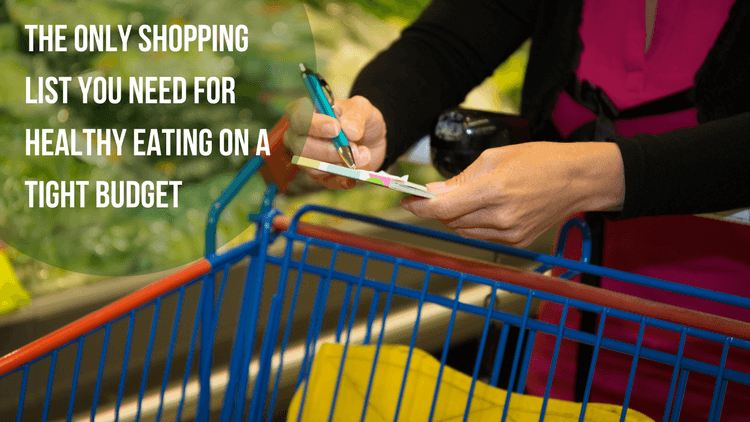
The Only Shopping List You Need For Healthy Eating On A Tight Budget
Healthy eating is often associated with spending a lot at the grocery store. And if you were to purchase everything fresh, organic, and ready-made, this misconception would be correct. However, this method of grocery shopping isn’t the only way to eat healthily. In fact, there are countless ways to eat healthily on a budget, even if your budget is only $30 to $40 per week.
In this article, we outline our top 8 quick tips for creating, and sticking to, a budget. Then we’ll provide a sample grocery list that makes it simple to buy good food which won’t go bad and which supports your weight loss goals.
8 quick tips for creating, and sticking to, a food budget
Whether out of necessity or frugality, a food budget is a great tool to have at the grocery store. It’ll prevent you from walking around aimlessly and picking up whatever sounds good at the time, and it’ll stop you from overspending and winding up strapped for cash at the end of the month.
However, sticking to a budget isn’t as simple as creating one. A lot of time and thought need to go into it, and your preferences and a whole host of other factors must be considered if you want to plan 21 meals per week for as little as $30 to $40.
Here are our 8 quick tips for doing so successfully:
- Track spending for a month. Do you know how much you usually spend at the grocery store? Do you understand whether you spend a lot on drinks or whether your spending is focused on food? The simplest way to create a realistic grocery list is to keep all of your receipts for a month. Doing so, and creating a spreadsheet to categorize your purchases, will help you understand where you might be wasting money and the general distribution of your purchases.
- Track weekly, not monthly. While you can set both weekly and monthly budgets, you should track weekly. Doing so is simpler because it’s on a smaller scale, and it’ll ensure you don’t run out of money at the end of the month.
- Prioritize groceries. You may want a lot of foods, but should you buy them? Probably not! Your grocery list on a $30−40 weekly budget should include frozen vegetables, grains, and other foods that won’t go bad. This will prevent waste and ensure that if you don’t use something this week, you can still use it next week.
- Stick to eating at home. If you budget for groceries and then eat out, you’re spending money you don’t have and potentially wasting the food you bought at the store. Eating out can also be something you do because you’re lazy and don’t feel like cooking the food from the store. If you find yourself tempted, make sure you plan your meals based on ease and as few ingredients as possible to ensure you don’t fall into this trap.
- Try to plan for variety. It can be difficult to plan a variety of meals with a small budget, meaning that you’ll often need to be ok with redundancy. However, if you can change up the same meals in small ways − perhaps with different spices, frozen vegetables, or other variations − you should.
- Keep a list on your fridge. If you find it taxing to make grocery lists by sitting down at the end of the week, it’s smart to keep a running list on your fridge. If there’s a meal you like, write down ingredients as you run out of them. This makes it simpler to keep a list and keep ingredients in your home that you’ll continue to use week after week. This is important because you don’t want to purchase something once, only to realize later that you won’t use it again.
- Preserve your leftovers. Leftovers are one of the best parts about keeping a grocery list and preparing a few meals, because you can use them throughout the week. This saves you time and energy, and ensures nothing goes to waste.
- Get everything you need in one trip. It’s easy to forget something you need, return to the store, and buy more than you intended as a result. Be comprehensive with your list so you can visit the store once without needing to return until the following week.
Check also: How to read food labels the right way >>

The only grocery list you’ll ever need for healthy, budget-friendly eating
Don’t be fooled by what you see in the media − you can eat healthily without buying everything fresh, organic, or from the “healthy lifestyle” grocery stores.
If you’re looking to eat healthily on $30−40 per week, here’s a simple list of the foods you should be buying:
- Grains. Rice and pasta are both great staples that won’t go bad! Plus, you can easily make pasta and stir different meats and vegetables into rice to add variety without putting too much strain on the budget. You may also want some wholegrain bread for toast or sandwiches.
- Frozen vegetables. Fresh vegetables are great, but if you don’t use them, or don’t use them quickly enough, they’ll spoil. Frozen vegetables are often on sale and are inexpensive. You can stock up when they’re on sale without the risk of them going bad.
- Beans/legumes. Beans are cheap and add protein and other nutrients to many different meals, like rice, tacos, burrito bowls, and more.
- Meat. Meat can be a challenge on a budget, because it can be expensive. However, if you stick to less expensive meats, like chicken, you can still enjoy it, freeze the extra, and add it to pasta, tacos, or other inexpensive dishes.
- Oatmeal. Oatmeal is a great healthy breakfast if you’re on a budget because you can buy a lot without spending a lot. Purchase some spices − like cinnamon and nutmeg − and peanut butter and you can switch up the flavor while still eating the same “meal” every day.
- Breakfast foods. While cereal can be expensive, it can also be cheap when on sale. You may also want to pick up some eggs for a healthy, protein-packed breakfast.
- Sauces/condiments. Ketchup, pasta sauce, mustard, sour cream, salsa, and other sauce bases or condiments can add flavor to what could otherwise be considered boring dishes.
Here are just some of the many meals you can make with these items:
- burrito bowls
- overnight oats
- black beans and rice
- pasta with vegetables
- grilled chicken with vegetables
- scrambled eggs with peanut butter toast
Of course, what you can make is only limited by your creativity!
Eating healthily is possible for everyone …
… including those on a limited budget!
What are some meals you make when you’re eating healthily on a budget? Share your ideas in the comments below!




